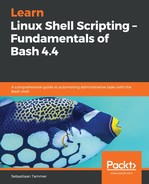We now know it's relatively easy to get the words Hello world! to appear on our terminal. A simple echo "Hello world!" does just the trick. However, if we wanted to do this multiple times, how would we go about it? You could suggest using any kind of loop, which would indeed allow us to print multiple times. However, that loop also requires some extra code and planning up front. As you will notice, in practice loops are great for iterating over items, but not exactly suitable for reusing code in a predictable manner. Let's see how we can use a function to do this instead:
reader@ubuntu:~/scripts/chapter_13$ vim hello-world-function.sh
reader@ubuntu:~/scripts/chapter_13$ cat hello-world-function.sh
#!/bin/bash
#####################################
# Author: Sebastiaan Tammer
# Version: v1.0.0
# Date: 2018-11-11
# Description: Prints "Hello world!" using a function.
# Usage: ./hello-world-function.sh
#####################################
# Define the function before we call it.
hello_world() {
echo "Hello world!"
}
# Call the function we defined earlier:
hello_world
reader@ubuntu:~/scripts/chapter_13$ bash hello-world-function.sh
Hello world!
As you see, we first defined the function, which is nothing more than writing the commands that should be executed once the function is called. At the end of the script, you can see we execute the function by just entering the function name, as we would any other command. It is important to note that you can only call a function if you have previously defined it. This means that the entire function definition needs to be higher in the script than its call. For now, we'll place all functions as the first items in our scripts. Later on in this chapter, we'll show you how we can be more efficient with this.
What you saw in the previous example was the first of two possible syntaxes for function definition in Bash. If we extract just the function, the syntax is as follows:
function_name() {
indented-commands
further-indented-commands-as-needed
}
The second possible syntax, which we like less than the previous one, is this:
function function_name {
indented-commands
further-indented-commands-as-needed
}
The difference between the two syntaxes is the absence of either the word function at the beginning or () after the function name. We prefer the first syntax, which uses the () notation, as it is much closer to the notation of other scripting/programming languages and should thus be much more recognizable for most. And, as an added bonus, it is shorter and simpler than the second notation. As you might expect, we'll continue using only the first notation in the rest of the book; the other was presented for completeness (and it is always convenient to understand it if you come across it online when researching for your scripting!).
